セミナーレポート
388 ニュース
-
2022-03-22
セミナーレポート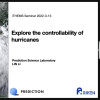
iTHEMS Math Seminar by Dr. Lin Li on March 18, 2022
In March 18, there was a seminar by Dr. Lin Li. He explained his theoretical research on the control of hurricane. The main difficulty is that the order of the energy of the so large that it is 106 times larger than the energy we could use. To overcome this difficulty, he explained some ideas and his simulation on how his ideas will work. Reported by Keita Mikami
-
2022-03-15
セミナーレポート
iTHEMS Math Seminar by Dr. Pengyu Liu on March 11, 2022
In March 11, there was a math seminar by Dr. Pengyu Liu from computational climate science research team. In the first part, he explained two extract rules to obtain Boolean function from the neural network. In the second part, he explained how we can apply results in the first part to predict human Dicer cleavage sites. Reported by Keita Mikami
-
2022-03-15
セミナーレポート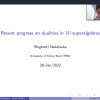
iTHEMS Math Seminar by Dr. Shigenori Nakatsuka on January 28, 2022
Dr. Shigenori Nakatsuka from Kavli IPMU gave us a talk on dualities in W-superalgebras. In the first half of the talk he reviewed some basic concepts of vertex superalgebras, in particular W-superalgebras, and the Feigin--Frenkel duality, which states that the W-algebras in a certain class are isomorphic to the other W-algebras associated with the dual Lie algebras and the dual levels. In the latter half of the talk he introduced dualities beyond the Feigin--Frenkel duality including his recent work with Creutzig, Genra, and Sato. One of the remarkable results is the proof of the Feigin--Semikhatov conjecture, which gives a correspondence between the W-algebras associated with certain Lie algebras and the W-superalgebras associated with the corresponding Lie superalgebras. His talk was so stimulating that we could enjoy the mathematics of W-algebras. Reported by Mizuki Oikawa
-
2022-03-11
セミナーレポート
iTHEMS - R-CCS(FTRT) Joint Online Seminar by Prof. Gergely Fejos on February 18, 2022
On Feb.18, 2022, Dr. Gergely Fejos (Eotvos Lorand Univ., Hungary) gave a talk at the first iTHEMS - R-CCS(FTRT) Joint Seminar. He reported a functional renormalization group study of the three dimensional Ginzburg--Landau potential for the chiral phase transition in three flavor quantum chromodynamics. The order of the phase transition in this system has long been thought to be first-order, but his conclusions suggest the possibility of a second-order phase transition. A lively discussion took place between the speakers and the audience on this interesting result. Reported by Tetsuo Hatsuda
-
2022-03-10
セミナーレポート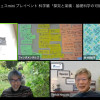
ファンダメンタルズ フェスmini プレイベント 科学篇 「探究と架橋:基礎科学の可能性」が2022年3月10日に行われました
2022年3月10日に基礎科学と社会の関わりをテーマにして討論会が開催されました。数学者の佐々田さん、人類学者の山極さん、そして物理学者の初田さんが、アーテイストの坪井あやさんをモデレータに、自然科学と社会科学における普遍性とは何か、基礎科学と社会を繋ぐ”触媒”としての科学者の役割などについて、活発な議論が行われました。 動画はyoutubeで配信されていますので、ぜひ関連リンクを御覧ください。
-
2022-03-10
セミナーレポート
iTHEMS Biology Seminar by Prof. Atsushi Mochizuki on March 10, 2022
In this week’s biology seminar, with great honor, we have Prof. Mochizuki to give us an interesting talk on “Independent regulation of multiple checkpoints in cell-cycle network system-Biological function originated in the law of localization-”. He showed us how mathematical analysis about the complex cell cycle networks can provide knowledge on non-trivial behaviors in regularization systems. The transformation from complex cell cycle networks to structural sensitivity matrix is amazing. He and his collaborator found the “buffering structure” which are essential local characters as the origin of biological function. Furthermore, “buffering structure” can generally appear in chemical reaction network including complex formation. He specially studied the G1-S and G2-M checkpoints in cell cycle. The analyses clarified that, even the two checkpoints are regulated by different protein complexes (Cdc2-Cdc13 and Cdc2-Cig2, respectively) with common species of proteins and activation reactions conform a complicated network, these two complexes are regulated by disjoint sets of reaction parameters in the system. We are looking forward to the further study of comparison with cell cycle experimental data. Many questions and discussions arose from the audiences. We appreciated very much the time Prof.Mochizuki shared with us. Reported by Yingying Xu
-
2022-03-09
セミナーレポート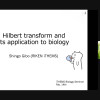
iTHEMS Biology Seminar by Dr. Shingo Gibo on February 17, 2022
Many biological time-series data are not stationary, which makes it difficult to analyze the instantaneous phase and amplitude. In the iTHEMS Biology seminar on February 17, I talked about Hilbert transform, which is known as a method to estimate the phase and the amplitude dynamics of nonstationary time-series. First, I explained the mathematical background of the method. Then, I introduced some applications of this method to chronobiology, virus dynamics, and acoustic engineering. In this seminar, there were many questions and comments from audiences. Thank you very much!
-
2022-03-09
セミナーレポート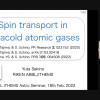
ABBL/iTHEMS Astro Seminar by Dr. Yuta Sekino on February 18, 2022
On 18th Feb. 2022, Dr. Yuta Sekino gave an excellent introductory talk on Spin transport in ultracold atomic gases. In his talk, we discussed the usefulness of spin transport as a probe for many-body properties in ultracold atoms. In the first part, we focused on the conductivity of alternating spin current, which includes information on superfluid gap, pseudogap, and topological phase transition. In the latter part, we considered mesoscopic spin transport between two Fermi gases weakly connected with each other. Finally, we discussed similarities of ultracold atoms to neutron star matter. Reported by Shigehiro Nagataki
-
2022-03-01
セミナーレポート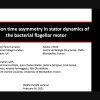
iTHEMS Biology Seminar by Dr. Ashley Nord and Dr. Rubén Pérez-Carrasco on February 24, 2022
Dr. Ashley Nord (Centre de Biologie Structurale/CNRS, France) and Dr. Rubén Pérez-Carrasco (Imperial College London, UK) gave a very interesting talk on the dynamics of stator units, the ion channels that generate torque for bacterial flagella. In the first half of the presentation, Dr. Ashley explained how the stator units produce torque once they are bound to the flagellar structure. Their experiment was able a) to track magnetic nanoparticles attached to E. coli flagella, and b) to set two initial conditions for the number of bound stator units. The work differs from the traditional views of the field because it shows -- for the first time -- the existence of two sets of relaxation times for stator units [1,2]. In the second part of the talk, Dr. Rúben discussed various stochastic models with asymmetric relaxation times to describe the dynamics of stator units. According to estimates via approximate Bayesian computation, the extended catch bond model with additional bound states performed better than other alternatives. If confirmed, their conclusion could give important hints and improve our understanding of biochemical processes in flagellar motors. Reported by Gilberto Nakamura
-
2022-02-28
セミナーレポート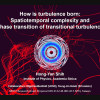
Quantum Matter SG seminar by Dr. Hong-Yan Shih on February 24, 2022
The Quantum Matter Study Group invited Dr. Hong-Yan Shih from Academia Sinica to talk about the phase transitions of turbulence dynamics. In the beginning, she introduced the turbulence and the phase transition between laminar flow and turbulence. Surprisingly, this phase transition shares a unified picture with the predator-prey system. Then, she showed the connection between this fluid dynamics and the biosystem with the same university class. It is an inspiring interdisciplinary study. Reported by Ching-Kai Chiu
-
2022-02-21
セミナーレポート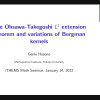
iTHEMS Math Seminar by Dr. Genki Hosono on January 14, 2022
Dr. Genki Hosono gave us a stimulating talk on pluripotential and $L^2$ methods in complex geometry. The talk was carefully designed not only for non-mathematicians but also for experts around the topic. He began his talk with the definition and basic properties of subharmonic function and its multivariable version in complex geometry: plurisubharmonic function. He then introduced Bergman kernel and explained a variational approach to Ohsawa-Takegoshi $L^2$ extension theorem, which is an extension theorem of holomorphic function with a bound on $L^2$ norm weighted by a plurisubharmonic function. Finally he explained Deng-Wang-Zhang-Zhou’s result on a `reverse direction’ of Ohsawa-Takegoshi theorem and his result with Inayama on a variant result. His explanations were very clear and quite valuable for us. Reported by Eiji Inoue
-
2022-02-21
セミナーレポート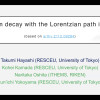
NEW WG Seminar by Mr. Takumi Hayashi on February 15, 2022
Takumi Hayashi (Tokyo/RESCEU) gave a talk on Lorenzian path-integral approach to false vacuum decay [1]. Conventionally, false vacuum decay has been discussed within the Euclidean formalism developed by Coleman, but it may suffer from several subtle issues when applying to cosmological problems. Takumi proposed a new formulation for false vacuum decay and computed the bubble nucleation rate by directly evaluating a Lorenzian path integral based on the Picard-Lefschetz theory. Takumi discussed nucleation of bubbles with various sizes, not limited to the critical one only to which the Euclidean formalism can be applied, and showed that nucleation of small bubbles is more probable than the critical one. More than 20 physicists have joined the seminar and enjoyed fruitful discussions. Reported by Hidetoshi Taya
-
2022-02-16
セミナーレポート
ABBL/iTHEMS Astro Seminar by Dr. Yutaka Hirai on January 28, 2022
Dr. Yutaka Hirai gave an excellent talk on Galactic archaeology with r-process elements. He showed that his high-resolution simulations of galaxies suggest that binary neutron star mergers play an important role in enriching r-process elements in dwarf galaxies and the Milky Way. He also showed that r-process enhanced stars in the Milky Way tend to form in dwarf galaxies previously accreted to the Milky Way. He demonstrated that the abundance of r-process elements in stars can be used as an indicator for the early evolution of the Milky Way. Reported by Shigehiro Nagataki
-
2022-02-15
セミナーレポート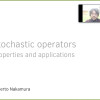
iTHEMS Biology Seminar by Dr. Gilberto Nakamura on February 10, 2022
Stochastic processes describe systems in which one or more variables fluctuate randomly. In the first part of the talk, I reviewed basic concepts in stochastic processes and how to express them in terms of localized spin operators and the probability vector (PV). This framework is convenient to compute statistics away from meanfield approximations because it can borrow methods traditionally used in many-body problems in Physics. The second part of the talk addressed the equation for the squared norm of the PV and its correspondence with the Rényi entropy. The general idea and challenges of employing estimates of the Rényi entropy were discussed shortly after. As a practical biological application, I explained the dynamical equations for averages and fluctuations in a simple stochastic epidemic model, highlighting the effects of noise and correlations in heterogeneous finite systems.
-
2022-02-14
セミナーレポート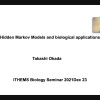
iTHEMS Biology Seminar by Dr. Takashi Okada on December 23, 2021
The Hidden Markov Models (HMM) have been used in a variety of fields for different purposes. I reviewed HMM and basic algorithms such as the forward algorithm. Then, I explained how this statistical framework can be applied to biological problems.
-
2022-02-02
セミナーレポート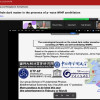
DMWG Seminar by Dr. Kenji Kadota on January 31, 2022
Weakly Interacting Massive Particles (WIMPs) have long been a leading candidate of dark matter(DM). However, no signatures are found in any kinds of experiments. Investigation of the alternatives is now rapidly growing. Primordial black holes (PBHs), which are formed in the early Universe and source the gravitational potential for baryonic components to evolve, are being widely discussed and searched now. Recent progress of the gravitational, as well as electromagnetic, observations of the Universe already excludes a large portion of the parameter space of PBH as DM. So if it contributes to DM, it is natural to also consider contributions from other components such as WIMPs. In such a situation, PBHs are dressed with WIMP halos. Then WIMP annihilation proceeds in the vicinity of the central PBH and a cored structure is expected depending on the annihilation rate. This dependence of the core structure on the annihilation rate leads to a tricky behavior in the constraints for PBH-WIMP mixed scenarios. Also, when PBHs are abundantly formed, we cannot neglect their clustering effects on the constraints obtained in the observable Universe because the dressed PBH with WIMP indicates the clustering of WIMP halos in host galaxies. In this case, the boost factor, which appears naturally in the scenario of pure WIMP DM models, needs to be evaluated in such a way that regarding the clustering of PBHs. Those interesting phenomena are only a part of examples that we can expect in the PBH-WIMP mixed scenario for DM. Varieties of possibilities are waiting for our investigations. Discussions are blooming now! Reported by Nagisa Hiroshima
-
2022-01-28
セミナーレポート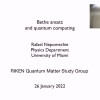
Quantum Matter SG seminar by Prof. Rafael I. Nepomechie on January 26, 2022
The Quantum Matter Study Group invited Prof. Rafael Nepomechie from the University of Miami to talk about the Bethe ansatz and realizing Bethe states in quantum computers. In the beginning, he used the Heisenberg chain to introduce the coordinate Bethe ansatz. In condensed matter physics, it is extremely difficult to solve many-body Hamiltonians. For this specific Heisenberg model, Bethe came up with a judicious method for finding the exact many-body wave function. The many-body problem is transformed to solving the Bethe equations. Unfortunately, it is also hard to solve these equations completely. Prof. Nepomechie presented an alternative approach to find the exact wave function and hence the solution to the Bethe equations through quantum computation. He found that, by using specific quantum operations, the exact wave function of the Heisenberg model can be presented in the quantum computer with a probability decaying as the factorial of the number magnons that make up the wave function. It is interesting to learn about this connection between the Bethe ansatz and quantum computing. Discussions were made how to increase the probability of the discussed scheme and how to extend it to find the complete set of Bethe roots for larger systems. Reported by Thore Posske (University of Hamburg, Germany) and Ching-Kai Chiu
-
2022-01-28
セミナーレポート
iTHEMS Biology Seminar by Prof. Kenta Ishimoto on January 27, 2022
We successfully had a great time thanks to Dr. Kenta Ishimoto's fantastic talk, in which he talked about the basic background of fluid dynamics, followed by two topics of his own research. Thank you again for the fantastic talk! Reported by Ryosuke Iritani
-
2022-01-25
セミナーレポート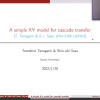
NEW WG Seminar by Mr. Tomohiro Tanogami on January 20, 2022
Tomohiro Tanogami from Kyoto University gave a talk titled "A simple XY model for cascade transfer." Cascade transfer is a ubiquitous phenomenon that appears in various physical systems. During a cascade transfer an inviscid conserved quantity such as energy is transferred conservatively from large/small to small/large scales, which results in a universal scaling law in the spectrum (e.g., Kolmogorov energy spectrum). In the talk, Tomohiro proposed a simple XY model which shows inverse energy cascade with a non-Kolmogorov energy spectrum and pointed out that the model may characterize a novel "universality class" of cascade transfer. Tomohiro also explained possible relations between his model and, e.g., spin and atmospheric turbulences. About 20 physicists have joined the seminar and enjoyed discussions from various viewpoints. Reported by Hidetoshi Taya
-
2022-01-20
セミナーレポート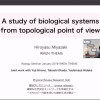
iTHEMS Biology Seminar by Dr. Hiroyasu Miyazaki on January 20, 2022
In the iTHEMS Biology Seminar on 20th January, Dr. Hiroyasu Miyazaki (RIKEN iTHEMS) gave a talk on the topological aspect of chemical reaction network. His talk is composed of two parts: motivation and result part and method part. In the first part, he mentioned the reduction of the chemical reaction network in E. Coli and its result which shows the same steady state as that before the reduction. In the second part, he explained how the network should be reduced. The topological information of the network can be described by using the matrix and the vector. He explained that the quotient network is defined to have a sequence of linear maps called “exact sequence”, which describes the relation among the original network, the subnetwork and the quotient network. We enjoyed his beautiful talk. From the audiences, the lively discussion arose during and after the talk. Thank you very much, Hiroyasu! Reported by Hiroshi Yokota
-
2022-01-18
セミナーレポート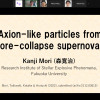
DMWG Seminar by Dr. Kanji Mori on January 17, 2022
In this era of multi-messenger astronomy, axion-like particle (ALP) searches using astrophysical transients are now excitingly discussed. ALPs are an extended class of particles from QCD axion, which could solve the strong CP problem of the Standard Model, and dark matter (DM) candidates of various connections to the physics beyond the Standard Model. ALPs could interact with our sector through their coupling to the photon, electron, and/or nucleons. The coupling of ALP to the photon is previously investigated using observations of SN 1987A, the most famous supernova explosion. MeV gamma-ray signals are expected when considering the conversion of ALP outside the stellar envelope, hence no observations of the associated gamma-ray emission to the supernova lead to the constraint on the coupling strength, for example. Also, the existence of such coupling should modify the dynamics of supernovae. When a star explodes, the difference between the masses of the progenitor star and the resulting compact object sources the radiation, neutrino emission, and kinetic energy of the ejecta material. ALP could be an additional channel for the energy release while its absorption heats the supernova. The balance between heating and cooling controls the supernova dynamics and shock restoration, which directly relates to the electromagnetic observables. Dr. Mori has shown that the heating rate is very sensitive to the coupling strength and enhancement of the electromagnetic emission is expected in the pre-supernova stage. The signatures could also be visible in the neutrino sector after the explosion. The results are fantastic, and there are a lot of things to do. For example, the inclusion of the ALP-nucleon coupling effects is an interesting direction to pursue. Updates in the understanding of stellar models are important as well. We should see the signature of ALP in the near future in this field! Reported by Nagisa Hiroshima
-
2022-01-17
セミナーレポート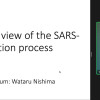
iTHEMS Biology Seminar by Dr. Wataru Nishima on January 13, 2022
Dr. Wataru Nishima (New Mexico Consortium, USA) gave a very interesting presentation about his published paper on the spike protein of the SARS-CoV-2, the virus which causes COVID-19 [1]. He described the conformational change which the SARS-CoV-2 spike protein undergoes when it fuses with the host cell to initiate infection. His work offers and interesting alternative view of the process wherein parts of the spike protein ends up inside the host cell. This differs from the usual view where the spike protein would be left on the outside of the cell after virus fusion with the host. This alternative hypothesis could have important implication for better understanding disease severity, e.g. based on the possible toxic effect of spike protein components shed as part of the fusion process. Dr. Nishima's expertise is primarily in Molecular Dynamics and Bioinformatics and he is very interested to establish new collaborations with iTHEMS members. Reported by Catherine Beauchemin
-
2022-01-12
セミナーレポート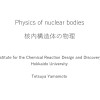
iTHEMS Biology Seminar by Prof. Tetsuya Yamamoto on January 6, 2022
On January 6th, Prof. Tetsuya Yamamoto gave us a comprehensive talk about the physical aspects of nuclear bodies. He first introduced the liquid-liquid phase separation and other self-assembly mechanisms in soft-matter physics, such as micelle formation, with motivations from the experimental side. In the main part, he told us about three recent topics regarding how RNAs' dynamics and sequence properties lead to different types of assembly of nuclear bodies. The mathematical formulation, schematic figures, and comparisons with experiments were clear to understand. We are very grateful to Prof. Yamamoto for the exciting seminar. Reported by Kyosuke Adachi
-
2021-12-28
セミナーレポート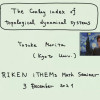
iTHEMS Math Seminar by Prof. Yosuke Morita on December 3, 2021
On December 3, Yosuke Morita from Kyoto university gave a talk titled “The Conley index of topological dynamical systems” at the iTHEMS math seminar. He reviewed the fundamental concepts of study of topological dynamical systems and introduced the notion of index neighborhood which is used to define his refined Conley index. His talk contained many instructive examples which enable us to understand his talk easily. Finally, his refined Conley index is defined as a functor into a category of (equivariant) condensed sets. This gives new conceptual understanding of Conley index in terms of condensed set introduced by Clausen and Scholze recently. His talk was very interesting and stimulated many questions and discussions. I believe it was a very worthwhile time for many participants. Reported by Masaki Taniguchi
-
2021-12-28
セミナーレポート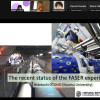
DMWG Seminar by Prof. Hidetoshi Otono on December 15, 2021
Among kinds of approaches for dark matter (DM), collider experiments are advantageous in their high precision. The FASER (ForwArd Search ExpeRiment at the LHC) is equipment to probe long-lived particles created at the interaction point of the LHC at the distance of about 400m. Particles pass through the absorber between the FASER detector and the interaction point and have enough lifetime to reach the FASER detector should leave signatures there. Dark photon and axion-like particles are good candidates for such species, as well as DM. The equipment is set at the front of the LHC beam direction. The position is really good at reducing the background particles and making use of already existing but not used space. Multiple layers of scintillators, emulsion for neutrino detection, silicon trackers, the decay volume for new particles with dipole magnets, and calorimeter at the endpoint consists of the facility. In combination with the works of these pieces, new long-lived particle signatures as rare-decay signatures of neutral pion decay can be searched. It is already working well with LHC Run 3 and neutrino properties are now being probed. Furthermore, a new piece of the facility is decided to be installed to enhance the accessibility to axion-like particle signature in the channel of 2 photon decay. The installation does not disturb the current measurement and will be completed by the end of 2023. The FASER experiments should become a key facility to probe new particles at m~O(1) GeV scale. In addition, our understanding of the Standard Model sector is also significantly improved with its measurements. The collaboration is now intensively working. The idea for physics with FASER is highly welcomed. Stay tuned and work hard! Reported by Nagisa Hiroshima
-
2021-12-22
セミナーレポート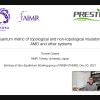
NEW WG Seminar by Dr. Tomoki Ozawa on December 20, 2021
Tomoki Ozawa (Tohoku/AIMR) gave a talk on "Quantum metric of topological and non-topological insulators in AMO and other systems." Quantum metric, or more generally quantum geometry, is attracting great interest recently in condensed-matter physics. Tomoki gave a pedagogical introduction to the concept of quantum metric as well as recent experimental progresses including the first detection of the quantum metric using a diamond NV center. Tomoki then explained his recent results on this topic, in particular, on relations among quantum metric, topology, and the Kähler geometry. More than 30 people have joined the seminar and enjoyed fruitful discussions. Reported by Hidetoshi Taya
-
2021-12-22
セミナーレポート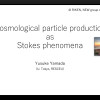
NEW WG Seminar by Dr. Yusuke Yamada on December 15, 2021
Yusuke Yamada (RESCEU/Tokyo) gave a talk on "Cosmological particle production as Stokes phenomena." Particle production from the vacuum takes place in the presence of time-dependent backgrounds, and is of interest in various fields of physics. Yusuke reconsidered the particle production from a viewpoint of the Stokes phenomenon, a mathematical concept in theory of differential equations, and discussed its application to the early Universe. Yusuke pointed out that the Stokes-phenomenon viewpoint gives a systematic and powerful framework to investigate the realtime dynamics of the particle production. About 20 people have joined the seminar, and enjoyed active discussions during and even after the seminar. Reported by Hidetoshi Taya
-
2021-12-17
セミナーレポート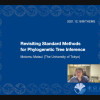
iTHEMS Biology Seminar by Prof. Hidetoshi Shimodaira on December 16, 2021
On December 16, Dr. Motomu Matsui (University of Tokyo) gave a lecture titled "Revisiting Standard Methods for Phylogenetic Tree Inference" at the iTHEMS Biology Seminar. He described the Graph Partitioning (GS) method, a new molecular phylogenetic analysis method based on graph theory and clustering, and explained its usefulness when used with real data. The GS method can reveal protein family relationships that cannot be clarified by conventional molecular phylogenetic analysis using maximum likelihood or distance methods. It was a very meaningful seminar for many participants. Thank you very much! Reported by Yuki Yazaki
-
2021-12-17
セミナーレポート
ABBL/iTHEMS Astro Seminar by Prof. Jin Matsumoto on December 10, 2021
Prof. Jin Matsumoto (Assistant Professor, Keio Institute of Pure and Applied Sciences (KiPAS), Graduate School of Science and Technology, Keio University) gave a nice presentation on "Magnetic field dependence of neutrino-driven core-collapse supernova models". In the presentation, Prof. Matsumoto introduced his neutrino-radiation-hydrodynamics supernova code (3DnSNe, Takiwaki et al. 2016) to include magnetohydrodynamics (MHD). Using this code, he performed three-dimensional MHD simulations for the evolution of non-rotating stellar cores focusing on the difference in the magnetic field of the progenitors. He found that the neutrino-driven explosion occurs in both the weak and strong magnetic field models. It was concluded that the neutrino heating is the main driver for the explosion in his models, whereas the strong magnetic field slightly supports the explosion. Reported by Shigehiro Nagataki
-
2021-12-10
セミナーレポート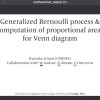
iTHEMS Math Seminar by Dr. Ryosuke Iritani on December 8, 2021
On December 8, Dr. Ryosuke Iritani (iTHEMS) gave a talk in Math Seminar. He talked about expectation value of certain random variables. He and his collaborators obtained a result on its explicit formula together with an algorithm of its fast calculation. This was the last Math Seminar talk of the year 2021. After the seminar there was an online Christmas party. Reported by Michiya Mori
-
2021-12-10
セミナーレポート
iTHEMS Biology Seminar by Prof. Hidetoshi Shimodaira on December 9, 2021
In this week’s biology seminar, the invited speaker Prof. Hidetoshi Shimodaira introduced his recent work about selective inference. Selective inference is an important statistical problem described also by another word “the file-drawer effect”. For example, Journals are much more likely to publish studies with low P values, and the readers never hear about the great number of studies that showed no effect and were filed way. This makes it difficult to assess the strength of a reported P value. The challenge of correcting for the effects of selection is a complex one. Prof. Hidetoshi Shimodaira explained a method to improve the previously proposed approximately unbiased test by adjusting the selection bias. This method is applied to predict trees and edges in phylogeny. In the seminar, he started by an interesting introduction of Darwin's theory of evolution and the tree of life. Based on this theory, modern phylogenetic inference is developed by analyzing DNA sequences of species as system relationships like trees. He also showed us, different statistical tests can give different P values of trees and edges in the trees. Therefore, we should be careful doing the tests and aware of the bias types in the problem. We thank Prof. Hidetoshi Shimodaira for his great talk and precious time with us! Reported by Yingying Xu
-
2021-12-07
セミナーレポート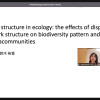
iTHEMS Biology Seminar by Dr. Yuka Suzuki on November 18, 2021
On November 18, Yuka Suzuki from Okinawa Institute of Science and Technology (OIST) gave a talk titled "Spatial structure in ecology: the effects of dispersal network structure on biodiversity pattern and stability in metacommunities" at the iTHEMS Biology Seminar. She introduced the basic concepts of spatial structure in ecology and explained how computational tools and network theoretical concepts are used to investigate spatial structures in ecology using her own study. Her talk was easy to understand and also very interesting and stimulated many questions and discussions. I believe it was a very worthwhile time for many participants. Thanks Yuka! Reported by Jeffrey Fawcett
-
2021-12-07
セミナーレポート
iTHEMS Math Seminar by Prof. Koichi Taira on November 26, 2021
In November 26, there was a seminar by professor Kouichi Taira. He explained the relations between self-adjointness and the completeness of the classical dynamics. He especially explained a conjecture that self-adjointness and completeness of classical dynamics are equivalent. He then gave some examples on this conjectures. Reported by Keita Mikami
-
2021-12-07
セミナーレポート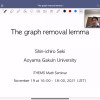
iTHEMS Math Seminar by Dr. Shinichiro Seki on November 19, 2021
On November 19, we invited Professor Shin-ichiro Seki from Aoyama Gakuin University to give a talk in the Math Seminar. He explained about the graph removal lemma, which is one of the key ingredients of the proof of his recent joint work with Kai, Mimura, Munemasa and Yoshino on a generalization of the celebrated Green-Tao theorem. In the first half of the talk, he gave a survey of Szemerédi's regularity lemma and the graph removal lemma, and explained how to extend the removal lemma to the case of (weighted) hypergraphs. In the second half of the talk, he presented Fox's result on a quantitative version of the graph removal, and discussed the prospects for future research. After the seminar, we had an online drinking party, and enjoyed a lot of discussion with the speaker. Reported by Hiroyasu Miyazaki
-
2021-12-07
セミナーレポート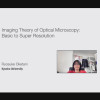
NEW WG Seminar by Prof. Ryosuke Oketani on November 25, 2021
Ryosuke Oketani from Kyushu University gave a talk on "Imaging Theory of Optical Microscopy: Basic to Super Resolution." Optical microscopy is a powerful tool to observe microscopic objects such as living micro-organisms. Recently, several super-resolution techniques have been developed, which enabled us to overcome the limit in spatial resolution caused by the wave nature of light. Ryosuke explained the basics and recent theoretical developments of optical microscopy and the super-resolution techniques. We also had fruitful discussions on the theory of optical microscopy from an interdiciplinary point of view. Reported by Hidetoshi Taya
-
2021-12-01
セミナーレポート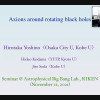
ABBL/iTHEMS Astro Seminar by Dr. Hirotaka Yoshino on November 12, 2021
Dr. Yoshino gave us a talk on his recent work on axions around rotating black holes. He showed results of his numerical simulations of so-called “superradiant instability” in which an axion field around a rotating black hole extracts the energy of the black hole. These results suggest that every astrophysical black hole is expected to wear a cloud of the axion. Reported by Akira Mizuta (ABBL, RIKEN)
-
2021-11-30
セミナーレポート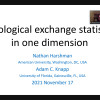
Quantum Matter SG seminar by Prof. Harshman Nathan on November 17, 2021
From American University, Prof. Nathan Harshman gave a seminar talk about topological exchange statistics in one spatial dimension on Nov. 17th, 2021. To introduce exchange statistics as done in the literature, he started with statistics for bosons and fermions and extended fractional and non-abelian exchange statistics. Then, the speaker raised questions about particle exchange in 1D and the collisions of the particles. Can a collision and an exchange at all be distinguished in one dimension? Is it reasonable to include points of coincidence in the configuration space? The way to resolve these problems is to introduce orbifolds. After pedagogically explaining the concepts of the orbifolds, he began to use the orbifold topological approach to study exchange statistics for any dimension. This approach offers great chances for novel abelian and nonabelian anyons in effectively 1D cold atom and condensed matter systems. Reported by Thore Posske (University of Hamburg, Germany) and Ching-Kai Chiu
-
2021-11-30
セミナーレポート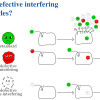
iTHEMS Biology Seminar by Prof. Catherine Beauchemin on October 14, 2021
Defective interfering virus particles (DIPs) are viruses that are defective in a very specific way that allows them to out-compete standard, non-defective virus. It is difficult to count DIPs because they can look too similar to standard virus. So instead, people are counting them based on their effect on suppressing the standard virus population. In this talk, C. Beauchemin explained the basic biology of virus replication, what are DIPs, and how they compete with standard virus. She presented her group's mathematical model (ordinary differential equation) that describes co-infection competition with DIPs and standard virus. She also showed applications of the mathematical model to show how experiments to count DIPs can give incorrect results, and proposed some solutions.
-
2021-11-30
セミナーレポート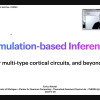
Information Theory SG Seminar by Dr. Enrico Rinaldi on November 29, 2021
In the first part, he introduced the concept of simulation-based inference (SBI), which is inference methods driven by machine learning, and show some examples. In the later part, he showed some preliminary results of SBI on a biological neural circuit. We had a great discussion during Enrico’s talk. Thanks again for the fantastic talk, Enrico! We look forward to working with you. Reported by Akinori Tanaka
-
2021-11-24
セミナーレポート
iTHEMS Math Seminar by Prof. Song Sun on October 22, 2021
In this seminar, Professor Song Sun started with explaining the most basic concepts like, Riemannian metric, curvature in differential geometry. He then introduced one of the most important equations differential geometry, the so-called Einstein equation. After defining the holonomy group of a Riemannian manifold, he explained Berger's classification of holonomy groups of Riemannian manifolds which are not locally symmetric. He then pointed out the importance of studying Riemannian manifolds with special/exceptional holonomy groups, e.g. Calabi-Yau manifolds, hyperkahler manifolds, G2 and Spin(7) manifolds. He concentrated on hyperkahler 4-manifolds and explained their geometry and topology in more details. In the end, he introduced his recent research result on studying Gromov-Hausdorff limit of hyperkahler 4-manifolds. Reported by Yalong Cao
-
2021-11-24
セミナーレポート
iTHEMS Math Seminar by Prof. Siqi He on October 15, 2021
In this seminar, Professor Siqi He started with mean curvatures and minimal submanifolds in differential geometry. Then he introduced the notion of calibrated geometry of Harvey-Lawson. As important examples of calibrated submanifolds, special Lagrangian submanifolds in Calabi-Yau manifolds are introduced. Then he explained a branch cover problem raised by Simon Donaldson and sketched a proof of it. Reported by Yalong Cao
-
2021-11-24
セミナーレポート
iTHEMS Math Seminar by Prof. Chen Jiang on October 8, 2021
In this seminar, Professor Chen Jiang started with several basic notions like geometric genus and canonical volume in birtaional geometry and introduced the question of geography problem. On algebraic surfaces, the boundary of geography problem is given by Miyaoka-Yau inequality and Noether inequality. Then he explained generalizations of the story on 3-folds, including his joint work with M. Chen and J.K.Chen. Finally he gave an outline for the proof of his main theorem. Reported by Yalong Cao
-
2021-11-24
セミナーレポート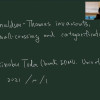
iTHEMS Math Seminar by Prof. Yukinobu Toda on October 1, 2021
In this seminar, Professor Yukinobu Toda started with the example of counting rational curves on hypersurfaces in complex projective spaces to illustrate ideas in enumerative geometry. Then he introduced several advanced topics including Donaldson-Thomas theory and mirror symmetry. Finally he explained his recent work on wall-crossing formulae for categorified DT invariants on resolved conifold. Reported by Yalong Cao
-
2021-11-18
セミナーレポート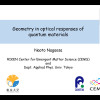
NEW WG Seminar by Prof. Naoto Nagaosa on November 15, 2021
Naoto Nagaosa (Tokyo/RIKEN) gave a talk on "Geometry in optical responses of quantum materials." Geometry and topology provide new insight into optical responses of solids and are of interdisciplinary interest in physics. After an excellent review on this topic made over the past decade, Naoto mainly discussed (i) shift current in noncentrosymmetric quantum materials driven by Berry phases, and (ii) Riemannian geometry in nonlinear optical responses. About 50 physicists from various fields have joined the seminar and enjoyed fruitful discussions during and after the seminar. Reported by Hidetoshi Taya
-
2021-11-17
セミナーレポート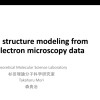
iTHEMS Biology Seminar by Dr. Takaharu Mori on November 4, 2021
On Nov 4th 2021, Dr. Takaharu Mori from Molecular Science Lab (Sugita Lab), RIKEN gave an online talk, entitled, "Protein structure modeling from cryo-electron microscopy data". He talked about the theoretical method to determine three-dimensional structures of biomolecules at near-atomic resolution, using a molecular dynamics (MD) simulation and also microscopy data. In addition, he showed their combined approach of coarse-grained model and all-atom model. According to him, Bayesian inference and machine learning are useful for the determination of biomolecule's 3D structure which can be the seeds of future collaborations between us. During the seminar, there were many discussions with iTHEMS members especially about the theoretical method to use recent microscopy data. We enjoyed his talk very much. Thanks, Mori-san! Reported by Gen Kurosawa
-
2021-11-17
セミナーレポート
iTHEMS Biology Seminar by Dr. Jae Kyoung Kim on November 11, 2021
On Nov 11th 2021, Prof. Jae Kyoung Kim from KAIST, South Korea gave an online talk at iTHEMS. The title of the talk is “Toward mathematical medicine: development of a new drug and digital medicine for sleep disorders”. In the seminar, Dr. Kim talked about mathematical model (e.g. IBM) of our daily rhythms when environment within cells is crowded by lipids, and its implication for obesity. In addition, he showed their successful collaboration with Pfizer and Samsung medical center. The talk thrilled us very much. There were many intensive discussions with iTHEMS members and also experimental biologists from outside. Thanks, Jae! Reported by Gen Kurosawa
-
2021-11-15
セミナーレポート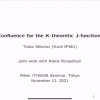
iTHEMS Math Seminar by Prof. Todor Milanov on November 12, 2021
Professor Todor Milanov gave a talk on his recent research on K-theoretic GW theory. He first recalled the definition of Gromov-Witten invariants and its K-theoretic generalization. Then he mentioned how to use genus 0 GW invariants to define quantum product on the usual cohomology group of a symplectic manifold. Such formulation has deep connection to integrable systems. He then introduced his research results, including a proof of the fact that small J-function in quantum cohomology of a Fano manifold can be obtained as a limit q -->1 of the small J-function in quantum K-theory. Reported by Yalong Cao
-
2021-11-15
セミナーレポート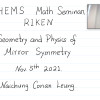
iTHEMS Math Seminar by Prof. Naichung Conan Leung on November 5, 2021
Professor Conan Leung gave an introductory talk to mirror symmetry. He first started with the discussion on the sum of inner angles of a triangle to illustrate the difference between our familiar Euclidean spaces and spaces with nontrivial curvature. He then introduced the notion of complex numbers and how it is related to solving polynomial equations in algebra. Recalling that gravity theory and quantum theory having very different nature of behaviour, he introduced super string theory as a potential unification of these two theories and its great impact to the study of modern mathematics, e.g. enumerative geometry, geometry of special holonomy. Finally he introduced mirror symmetry and how to understand it from the perspective of Fourier transform following a proposal of Strominger, Yau and Zaslow. Reported by Yalong Cao
-
2021-11-11
セミナーレポート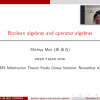
Information Theory SG Seminar by Dr. Michiya Mori on November 4, 2021
On November 4, Dr. Michiya Mori gave a talk entitled “Boolean algebras and operator algebras” at the Information Theory SG Seminar. He explained some of the basic concepts of Boolean algebra. Then he talked about some interesting issues and his contributions in the field. It was a very informative and stimulating talk. Reported by Yukimi Goto
-
2021-11-11
セミナーレポート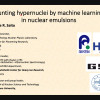
Astro-AI WG/Information Theory SG Joint Seminar by Dr. Takehiko Saito on November 8, 2021
The seminar was held online plus 4 people on-site. Dr.Saito gave a talk about “hunting hypernuclei by machine learning in nuclear emulsions”. Recent experimental studies with heavy ion beams have revealed that the nature of the hypertriton is unclear, especially on its biding energy and lifetime. The group led by Dr. Saito conducted measurements of them using nuclear emulsion, which requires a huge human load on visual image analyses. Therefore, they have developed machine learning models to detect events associated with production and decay of hypertriton in nuclear emulsions data, and successfully have discovered hypertriton events. Reported by Naomi Tsuji
388 ニュース
